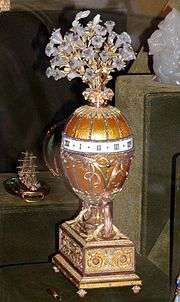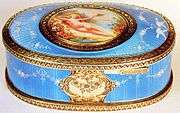Guilloché






Guilloché (or guilloche) is a decorative technique in which a very precise, intricate and repetitive pattern is mechanically engraved into an underlying material via engine turning, which uses a machine of the same name, also called a rose engine lathe. This mechanical technique improved on more time-consuming designs achieved by hand and allowed for greater delicacy, precision, and closeness of line, as well as greater speed.
The term "guilloche" is also used more generally for repetitive architectural patterns of intersecting or overlapping spirals or other shapes, as used in the Ancient Near East, classical Greece and Rome and neo-classical architecture, and Early Medieval interlace decoration in Anglo-Saxon art and elsewhere. Medieval Cosmatesque stone inlay designs with two ribbons winding around a series of regular central points are very often called guilloche. These central points are often blank, but may contain a figure, such as a rose.[1] These senses are a back-formation from the engraving guilloché, so called because the architectural motifs resemble the designs produced by later guilloché techniques.
Uncertain etymology
The name, as guilloché, is French, dating back at least to the 1770s,[2] and is often said to be called after a French engineer named Guillot, who invented a tool or turning machine. However no dates nor first name are provided for this shadowy figure, and many dictionaries seem suspicious of his existence.[3]
History
Engine turning machines were first used in the 1500–1600s on soft materials like ivory and wood and in the 18th century it was adopted for metal such as gold and silver.[4][5] Some accounts give the credit of developing tightly-packed engraved guilloché decoration to the Nuremberg glass-making dynasty of the Schwanhardt family in the 17th century,[6] using a wheel to engrave the glass.
Engine turning machines manufactured in the traditional fashion with cast iron and heavy wood bases and precision scraped machined surfaces have been made up to ca 1967 (e.g. Neuweiler und Engelsberger). Individuals continue the craft of making these elegant machines but they are in very limited quantities.[7]
A Guilloche Machine was granted a US Patent in 1968 by Wilhelm Brandstatter.[8] The original assignor was a firm called Maschinenfabrik Michael Kampf KG. A photo of this machine can be seen at Turati Lombardi's history page.[9]
In the 1920s and '30s, automobile parts such as valve covers, which are right on top of the engine, were also engine-turned. Similarly, dashboards or the instrument panel of the same were often engine-turned. Customizers also would decorate their vehicles with engine-turning panels similarly.
Guilloche describes a narrow instance of guilloche: a design, frequently architectural, using two curved bands that interlace in a pattern around a central space. Some dictionaries give only this definition of guilloche, although others include the broader meaning associated with guilloché as a second meaning. Note that in the original sense, even a straight line can be guilloché, and persons using the French spelling and pronunciation generally intend the broader, original meaning.[10][11][12] Translucent enamel was applied over guilloché metal by Peter Carl Fabergé on the Faberge eggs and other pieces from the 1880s.[13]
In today’s terminology
In consequence of the nature of the design, which is usually a series of lines that are, or look very much like they are interwoven into one another, any design engraved on metal, printed, or otherwise erected on surfaces such as wood or stone, that go in a similar style of constant wriggling that interlock - or look like they are interlocking - with one another, is referred to as guilloché.
Some of the more common ones are the following:
- Engraved (in metal, mainly sterling): in fine timepieces (mainly pocket watches), fine pens, jewelry charms, snuffboxes, hair-styling accessories, wine goblets etc. Examples of famous works of Guilloché are the engravings on Faberge eggs.
- Erected: on stone for architecture, in wood for styling, on furniture or molding, etc.
- Printed: on bank notes, currency or certificates, etc., to protect against forged copies. The pattern used in this instance is called a spirograph in mathematics, that is, a hypotrochoid generated by a fixed point on a circle rolling inside a fixed circle. It has parametric equations. These patterns bear a strong resemblance to the designs produced on the Spirograph, a children's toy.
Other names for guilloché
The engine turning machine characteristic of guilloché is called by other names in specific uses:
- Rose engine (metalwork)
- Straight line engine turning Tour à guilloché (metalwork)
- Holtzapffel lathe, named after the founder of an ornamental lathe manufacturer John Jacob Holtzapffel
- Decoration lathe (metalwork)
- Damaskeening (watch movements and horology)
- Geometric lathe (security printing)
- Cycloidal engine (security printing)
- Ornamental turning or ornamental lathe (woodcarving).
The different types of the machines refer to different models and different times during the development of the engine-turning machine.
See also
References
- ↑ "Guilloche", Osborne, Harold (ed), The Oxford Companion to the Decorative Arts, 1975, OUP, ISBN 0198661134
- ↑ Vocabulaire françois, ou, abrégé du Dictionnaire de l'Académie françoise, auquel on a ajouté une nomenclature géographique fort étendue. Ouvrage utile aux François, aux étrangers, & aux jeunes gens de l'un & de l'autre sexe, 1773
- ↑ Entry for "Guilloche" in Chambers Dictionary, 1998; the OED record the word from 1842 in English, but do not give an etymology.
- ↑ What kind of a machine did Faberge' use to engrave the gold under the enamel on his famous eggs and other irregular shapes? by Peter Rowe.
- ↑ Guilloché Enameled Luxuries: Engraved memories of a fanciful era, Professional Jeweler Archive, March 2001.
- ↑ "Schwanhardt", Osborne, Harold (ed), The Oxford Companion to the Decorative Arts, 1975, OUP, ISBN 0198661134
- ↑ Argent Blue pens
- ↑ GUILLOCHE MACHINE US Patent No. 3,406,454
- ↑ Photo of Guilloche Machine
- ↑ The Century Dictionary: An Encyclopedic Lexicon of the English Language By William Dwight Whitney 1889
- ↑ Roman Pavements by Henry Colley March 1906
- ↑ The Anglo-Saxon Review By Lady Randolph Spencer Churchill 1901.
- ↑ eBay Guides - The Guilloché Enamelling Process and Charm Collecting
External links
| Wikimedia Commons has media related to Guilloché. |
- Chisholm, Hugh, ed. (1911). "Guilloche". Encyclopædia Britannica (11th ed.). Cambridge University Press.
